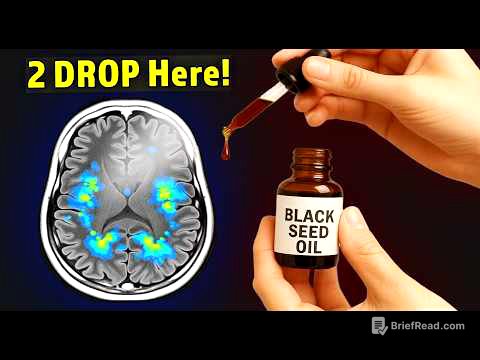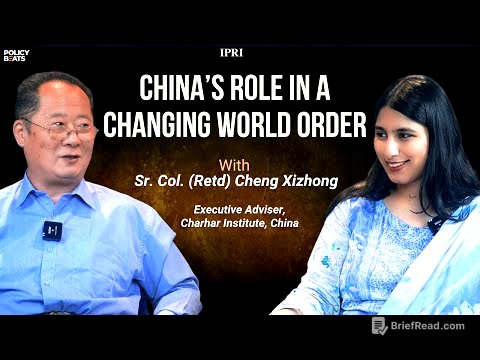TLDR;
This YouTube transcript, titled "The Body Keeps the Score Part 4," discusses the impact of trauma on memory, the historical understanding and treatment of trauma, and paths to recovery. It emphasizes the importance of acknowledging and integrating traumatic memories, the role of relationships and community in healing, and various therapeutic approaches, including EMDR, yoga, and neurofeedback. The text also touches on the political and social aspects of trauma, highlighting the need for societal awareness and support for trauma survivors.
- Traumatic memories are fragmented and sensory, differing from normal narrative memories.
- Historical perspectives on hysteria and trauma's impact on the body and mind.
- Recovery involves self-leadership, emotional regulation, and integrating split-off memories.
- Relationships, community, and specific therapies like EMDR, yoga, and neurofeedback aid in healing.
- Societal awareness and support are crucial for addressing trauma's widespread effects.
Uncovering Secrets: The Problem of Traumatic Memory [0:03]
The chapter begins with a quote reflecting on the quietness and soundlessness of traumatic memories, which disturb the author. The author then introduces the case of Julian, a man who seemingly repressed childhood sexual abuse by a priest, Father Shanley, until news of an investigation triggered his memories. Julian's experiences illustrate the complexities of traumatic memory and the controversies surrounding repressed memories. Julian's story includes panic attacks, seizures, and emotional distress, leading to his administrative discharge from the Air Force. He recalls fragmented memories of abuse, including strip poker games and fondling, and experiences reenactments during sexual encounters with his girlfriend. The author emphasizes that the primary concern in treating trauma is helping individuals tolerate their sensations and emotions without being overwhelmed, addressing self-blame, and accepting that the trauma was not their fault.
Normal Versus Traumatic Memory [10:08]
The chapter discusses the differences between normal and traumatic memory, noting that autobiographical memories are not precise reflections of reality but stories we tell. A study of Harvard men's war memories showed that most men modified their accounts over time, while those with PTSD did not. The key factor in memory retention is the level of arousal during the event. Traumatic experiences are not stored as coherent narratives but as fragmented sensory and emotional traces. In the late 19th century, the nature of traumatic memory was a central topic, particularly in the study of hysteria. Early researchers referred to traumatic memories as "pathogenic secrets" or "mental parasites" because they kept forcing themselves into consciousness.
Amnesia, Dissociation, and Reenactment [19:15]
Pierre Janet distinguished between narrative memory and traumatic memory, using the case of Irin, who had amnesia for her mother's death but reenacted the events. Traumatized people remember too little and too much simultaneously. Janet treated Irin with hypnosis, eventually helping her tell the story with appropriate feelings. Traumatic memories are triggered by specific elements, while ordinary memory is adaptive and social. Reenactments are frozen in time, lonely, humiliating, and alienating. Janet coined "dissociation" to describe the splitting off of memory imprints and predicted that without integration, individuals would experience a slow decline in functioning. Dissociation prevents trauma from becoming integrated into autobiographical memory, creating a dual memory system. The goal of treatment is association, integrating cutoff elements into the ongoing narrative of life.
The Origins of the Talking Cure [24:47]
Psychoanalysis was born on the wards of the Salpêtrière, with Freud acknowledging the reality of sexual abuse. Brewer and Freud's 1893 paper led to the "talking cure," where hysterical symptoms disappeared when the memory of the provoking event was brought to light. Recollection without effect produces no result unless there is an energetic reaction to the traumatic event. Language serves as a substitute for action, allowing the strangulated effect to find a way out through speech. Psychologists generally assume that telling the trauma story in great detail will help people leave it behind, a basic premise of cognitive behavioral therapy (CBT). The chapter concludes by noting that incidents of reenactment raise critical questions about recognizing traumatic stress and integrating past traumatic memory.
Traumatic Memory on Trial [29:56]
The chapter discusses the legal case against Paul Shanley, a priest accused of molestation, and the challenges of repressed memories in court. Julian, one of the victims, testified in Shanley's trial, which led to a guilty verdict. Shanley's attorney filed a motion for a new trial, challenging the admissibility of repressed memories as evidence. Despite leading psychiatrists and psychologists stating that repressed memory has never been shown to exist, the court unanimously upheld Shanley's conviction. The chapter sets the stage for a discussion on memory and forgetting and the ongoing debate over repressed memory.
The Unbearable Heaviness of Remembering [31:42]
Scientific interest in trauma has fluctuated over the past 150 years, with periods of neglect followed by renewed attention due to events like World War I and World War II. The chapter discusses the diagnosis of shell shock during World War I and the subsequent efforts to undermine claims for compensation. The official view was that well-trained troops would not suffer from shell shock. The chapter also touches on the fate of veterans in the United States, including the Bonus Army incident during the Great Depression. The horrors of war were memorialized in literature and art, such as Erich Maria Remarque's "All Quiet on the Western Front." Denial of the consequences of trauma can wreak havoc on society, as seen in the rise of fascism and militarism in the 1930s.
The New Face of Trauma [38:57]
The outbreak of World War II prompted the publication of accounts of work with World War I soldiers, serving as guides for treating soldiers with war neurosis. YouTube offers a direct window on the past, with documentaries like John Huston's "Let There Be Light" showing the predominant treatment for war neurosis at that time: hypnosis. Culture shapes the expression of traumatic stress. The chapter also discusses the treatment of PTSD after World War II and the reluctance of veterans to share their experiences. Military and civilian leaders came away from World War II with important lessons, such as the need to rebuild Europe and provide veterans with education and home mortgages.
Trauma Rediscovered [43:16]
The Vietnam War inspired numerous studies, the formation of scholarly organizations, and the inclusion of PTSD in the professional literature. Interest in trauma was exploding in the general public, with awareness of childhood sexual abuse, domestic abuse, and rape increasing. By the early 1990s, articles about a so-called false memory syndrome started to appear, stating that there was no evidence that people remember trauma any differently than they do ordinary events. The issue of delayed recall of trauma became a context for the pedophile scandals in the Catholic Church, with memory experts pitted against one another in courtrooms.
The Science of Repressed Memory [47:32]
There have been hundreds of scientific publications documenting how the memory of trauma can be repressed only to resurface years or decades later. Memory loss has been reported in people who have experienced natural disasters, accidents, war trauma, kidnapping, torture, concentration camps, and physical and sexual abuse. A study by Dr. Linda Meer Williams found that more than a third of women did not recall the abuse that was documented in their medical records. Recovered memories were approximately as accurate as those that had never been lost. Recent neuroscience research shows that memories that are retrieved tend to return to the memory bank with modifications.
Normal Versus Traumatic Memory [53:23]
A study comparing how people recall benign experiences and horrific ones found major differences in how the memories were organized and their physical reactions to them. Positive experiences were recalled as events from the past with a beginning, middle, and end, while traumatic memories were disorganized. Traumatized participants said that they had not been able to tell anybody precisely what had happened immediately following the event. As time went on, even more sensory details and feelings were activated, but most participants also started to be able to make some sense out of them. The study confirmed the dual memory system that Janet had described more than 100 years earlier.
Listening to Survivors [58:55]
Society is no different from the victims themselves in that nobody wants to remember trauma. In order to understand trauma, we have to overcome our natural reluctance to confront that reality and cultivate the courage to listen to the testimonies of survivors. The essence of trauma is that it is overwhelming, unbelievable, and unbearable. Each patient demands that we suspend our sense of what is normal and accept that we are dealing with a dual reality. The chapter concludes with the story of Nancy, who underwent a laparoscopic tubal ligation and remained aware nearly to the end.
Nancy's Story [1:01:44]
Nancy's story illustrates the existential reality of trauma, where time is folded and the past and present merge. Symbols related to the original trauma become contaminated and are hated, feared, and avoided. She exists in a dual state, with a pervasive numbness covered by a blanket, yet the touch of a small child pulls her back to the world for a moment. She has thought many times that she had recalled all the events around the surgery only to find a new one. An early sign of recovery came when Nancy needed another more extensive operation and chose a Boston hospital for the surgery. She left her CBT therapist to work with a psychodynamic psychiatrist and joined a Pilates class.
Healing from Trauma: Owning Yourself [1:11:59]
The chapter discusses healing from trauma and owning yourself, emphasizing that while the past cannot be undone, the imprints of trauma on the body, mind, and soul can be dealt with. Trauma robs individuals of self-leadership, and the challenge of recovery is to reestablish ownership of the body and mind. This involves becoming calm and focused, maintaining that calm in response to reminders of the past, being fully alive in the present, and not having to keep secrets from oneself. The chapter provides an overview of underlying principles and a preview of methods to accomplish these goals.
A New Focus for Recovery [1:14:44]
Trauma is more than a story about something that happened long ago; it involves emotions and physical sensations experienced as disruptive reactions in the present. While revisiting the trauma is necessary, it should only be done after feeling safe. The first order of business is to cope with feeling overwhelmed by sensations and emotions associated with the past. The engines of post-traumatic reactions are located in the emotional brain, which manifests itself in physical reactions. The rational brain cannot abolish emotions, sensations, or thoughts, but it can keep you from surrendering to intense reactions.
Lyic System Therapy [1:16:57]
The fundamental issue in resolving traumatic stress is to restore the proper balance between the rational and emotional brains. When triggered into states of hyper or hypoarousal, we are pushed outside our window of tolerance, becoming reactive and disorganized. Recovery from trauma involves the restoration of executive functioning and self-confidence. To change post-traumatic reactions, we have to access the emotional brain and do lyic system therapy, repairing faulty alarm systems and restoring the emotional brain to its ordinary job. The only way we can consciously access the emotional brain is through self-awareness.
Befriending the Emotional Brain [1:19:27]
Mainstream psychiatry has focused on using drugs to change how we feel, but we have inbuilt skills to keep us on an even keel. Emotions are registered in the body, and we can directly train our arousal system by how we breathe, chant, and move. Yoga practice markedly reduced PTSD symptoms in patients who had failed to respond to medication or other treatments. Learning how to breathe calmly and remaining in a state of physical relaxation is an essential tool for recovery. Emotional regulation is critical in managing the effects of trauma and neglect.
No Mind Without Mindfulness [1:22:50]
At the core of recovery is self-awareness, with the most important phrases in trauma therapy being "notice that" and "what happens next." Traumatized people live with seemingly unbearable sensations, and avoiding feeling these sensations increases vulnerability to being overwhelmed by them. Body awareness puts us in touch with our inner world, and simply noticing our annoyance, nervousness, or anxiety immediately helps us shift our perspective. Mindfulness puts us in touch with the transitory nature of our feelings and perceptions. Learning to observe and tolerate physical reactions is a prerequisite for safely revisiting the past.
Relationships [1:27:46]
Having a good support network constitutes the single most powerful protection against becoming traumatized. Safety and Terror are incompatible. Frightened adults respond to the same Comforts as terrified children. In order to recover, mind, body, and brain need to be convinced that it is safe to let go. Traumatized human beings recover in the context of relationships with families, loved ones, AA meetings, veterans organizations, religious communities, or professional therapists. The role of those relationships is to provide physical and emotional safety and to bolster the courage to tolerate, face, and process the reality of what has happened.
Choosing a Professional Therapist [1:36:10]
The training of competent trauma therapists involves learning about the impact of trauma, abuse, and neglect and mastering a variety of techniques to stabilize and calm patients, help lay traumatic memories and reenactments to rest, and reconnect patients with their fellow men and women. There is no one treatment of choice for trauma, and any therapist who believes that his or her particular method is the only answer to your problems is suspect. Feeling safe is a necessary condition for you to confront your fears and anxieties. Patients get better only if they develop deep positive feelings for their therapists.
Communal Rhythms and Synchrony [1:36:47]
From the moment of our birth, our relationships are embodied in responsive faces, gestures, and touch. Trauma results in a breakdown of attuned physical synchrony. The healing power of community as expressed in music and rhythms was brought home in the spring of 1997 when the author was following the work of the Truth and Reconciliation Commission in South Africa. The chapter also discusses the importance of sensory integration and attuned touch in therapeutic settings.
Getting in Touch [1:41:20]
Mainstream trauma treatment has paid scant attention to helping terrified people to safely experience their Sensations and emotions. The most natural way that we humans calm down our distress is by being touched, hugged, and rocked. Touch is the most Elementary tool that we have to calm down. The chapter includes a discussion with Bodywork practitioner Lea Sky about her practice with traumatized individuals. People who are terrified need to get a sense of where their bodies are in space and of their boundaries.
Taking Action [1:45:26]
The body responds to extreme experiences by secreting stress hormones, which are meant to give us the strength and endurance to respond to extraordinary conditions. Helplessness and immobilization keep people from utilizing their stress hormones to defend themselves. In order to return to proper functioning, this persistent emergency response must come to an end. Somatic therapies can help patients to relocate themselves in the present by experiencing that it is safe to move. The best way to overcome ingrained patterns of submission is to restore a physical capacity to engage and defend.
Integrating Traumatic Memories [1:50:51]
People cannot put traumatic events behind until they are able to acknowledge what has happened and start to recognize the invisible demons they're struggling with. Traditional Psychotherapy has focused mainly on constructing a narrative that explains why a person feels a particular way. Telling the story is important, but it does not guarantee that the traumatic memories will be laid to rest. When people fully recall their traumas, they have the experience they are engulfed by the sensory or emotional elements of the past. A trauma can be successfully processed only if all those brain structures are kept online.
Cognitive Behavioral Therapy (CBT) [1:54:14]
Cognitive behavioral therapy (CBT) was first developed to treat phobias and helps patients compare their irrational fears with harmless realities. When patients are repeatedly exposed to the stimulus without bad things actually happening, they gradually become less upset. CBT also tries to help patients deal with their tendency to avoid. However, reliving trauma reactivates the brain's alarm system and knocks out critical brain areas necessary for integrating the past. Prolonged exposure or flooding has been studied more thoroughly than any other PTSD treatment.
Drugs to Safely Access Trauma [2:04:26]
People have always used drugs to deal with traumatic stress, and mainstream Psychiatry follows this tradition. However, drugs cannot cure trauma; they can only dampen the expressions of a disturbed physiology and do not teach the lasting lessons of self-regulation. The chapter discusses the potential of MDMA for trauma treatment, as it decreases fear, defensiveness, and numbing, as well as helping to access inner experience. The chapter also touches on the use of antidepressants, tranquilizers, and antipsychotic agents in treating PTSD.
The Road of Recovery is the Road of Life [2:12:15]
The chapter concludes with the story of Bill, a Vietnam veteran who underwent multiple treatments over the years to deal with his traumatic stress. Bill's story illustrates the importance of integrating traumatic memories, befriending one's body, and finding a sense of purpose in life. His journey highlights the ongoing and evolving nature of recovery from trauma.
Language Miracle and Tyranny [2:17:38]
The chapter discusses the role of language in healing from trauma, noting that while trauma keeps us dumbfounded, the path out of it is paved with words. Silence about trauma leads to the death of the soul, and being able to say allowed to another human being what happened is a sign that healing can begin. Naming offers the possibility of a different kind of control. However, trauma stories obscure the fact that trauma radically changes people and that it is difficult to put that feeling into words. The chapter also touches on the limitations of language and the importance of body awareness.
Mindfulness [2:21:55]
The chapter discusses the importance of mindfulness and self-awareness in trauma recovery. The most important phrases in trauma therapy are "notice that" and "what happens next." Traumatized people live with seemingly unbearable Sensations, and avoiding feeling these Sensations increases vulnerability to being overwhelmed by them. Body awareness puts us in touch with our inner world, and simply noticing our annoyance, nervousness, or anxiety immediately helps us shift our perspective. The chapter also touches on the importance of relationships and finding a responsive community.
Choosing a Professional Therapist [2:21:55]
The training of competent trauma therapists involves learning about the impact of trauma, abuse, and neglect and mastering a variety of techniques to stabilize and calm patients, help lay traumatic memories and reenactments to rest, and reconnect patients with their fellow men and women. There is no one treatment of choice for trauma, and any therapist who believes that his or her particular method is the only answer to your problems is suspect. Feeling safe is a necessary condition for you to confront your fears and anxieties. Patients get better only if they develop deep positive feelings for their therapists.
Communal Rhythms and Synchrony [2:21:55]
From the moment of our birth, our relationships are embodied in responsive faces, gestures, and touch. Trauma results in a breakdown of attuned physical synchrony. The healing power of community as expressed in music and rhythms was brought home in the spring of 1997 when the author was following the work of the Truth and Reconciliation Commission in South Africa. The chapter also discusses the importance of sensory integration and attuned touch in therapeutic settings.
Getting in Touch [2:21:55]
Mainstream trauma treatment has paid scant attention to helping terrified people to safely experience their Sensations and emotions. The most natural way that we humans calm down our distress is by being touched, hugged, and rocked. Touch is the most Elementary tool that we have to calm down. The chapter includes a discussion with Bodywork practitioner Lea Sky about her practice with traumatized individuals. People who are terrified need to get a sense of where their bodies are in space and of their boundaries.
Taking Action [2:21:55]
The body responds to extreme experiences by secreting stress hormones, which are meant to give us the strength and endurance to respond to extraordinary conditions. Helplessness and immobilization keep people from utilizing their stress hormones to defend themselves. In order to return to proper functioning, this persistent emergency response must come to an end. Somatic therapies can help patients to relocate themselves in the present by experiencing that it is safe to move. The best way to overcome ingrained patterns of submission is to restore a physical capacity to engage and defend.
Integrating Traumatic Memories [2:21:55]
People cannot put traumatic events behind until they are able to acknowledge what has happened and start to recognize the invisible demons they're struggling with. Traditional Psychotherapy has focused mainly on constructing a narrative that explains why a person feels a particular way. Telling the story is important, but it does not guarantee that the traumatic memories will be laid to rest. When people fully recall their traumas, they have the experience they are engulfed by the sensory or emotional elements of the past. A trauma can be successfully processed only if all those brain structures are kept online.
Drugs to Safely Access Trauma [2:21:55]
People have always used drugs to deal with traumatic stress, and mainstream Psychiatry follows this tradition. However, drugs cannot cure trauma; they can only dampen the expressions of a disturbed physiology and do not teach the lasting lessons of self-regulation. The chapter discusses the potential of MDMA for trauma treatment, as it decreases fear, defensiveness, and numbing, as well as helping to access inner experience. The chapter also touches on the use of antidepressants, tranquilizers, and antipsychotic agents in treating PTSD.
The Road of Recovery is the Road of Life [2:21:55]
The chapter concludes with the story of Bill, a Vietnam veteran who underwent multiple treatments over the years to deal with his traumatic stress. Bill's story illustrates the importance of integrating traumatic memories, befriending one's body, and finding a sense of purpose in life. His journey highlights the ongoing and evolving nature of recovery from trauma.
Language Miracle and Tyranny [2:21:55]
The chapter discusses the role of language in healing from trauma, noting that while trauma keeps us dumbfounded, the path out of it is paved with words. Silence about trauma leads to the death of the soul, and being able to say allowed to another human being what happened is a sign that healing can begin. Naming offers the possibility of a different kind of control. However, trauma stories obscure the fact that trauma radically changes people and that it is difficult to put that feeling into words. The chapter also touches on the limitations of language and the importance of body awareness.
Mindfulness [2:21:55]
The chapter discusses the importance of mindfulness and self-awareness in trauma recovery. The most important phrases in trauma therapy are "notice that" and "what happens next." Traumatized people live with seemingly unbearable Sensations, and avoiding feeling these Sensations increases vulnerability to being overwhelmed by them. Body awareness puts us in touch with our inner world, and simply noticing our annoyance, nervousness, or anxiety immediately helps us shift our perspective. The chapter also touches on the importance of relationships and finding a responsive community.
The Unspeakable Truth [2:20:30]
Therapists have an undying faith in the capacity of talk to resolve trauma. Traumatic events are almost impossible to put into words. While trauma Keeps Us dumbfounded, the path out of it is paved with words carefully assembled piece by piece until the whole story can be revealed. Silence about trauma also leads to death, the death of the Soul. Being able to say allowed to another human being, "I was raped," or "I was battered by my husband," or "My parents called it discipline, but it was abuse," or "I'm not making it since I got back from Iraq" is a sign that healing can begin.
The Limits of Language [2:32:49]
Anyone who enters talk therapy confronts the limitations of language. We possess two distinct forms of self-awareness: one that keeps track of the self across time and one that registers the self in the present moment. The first, our autobiographical self, creates connections among experiences and assembles them into a coherent story. The other system, moment-to-moment self-awareness, is based primarily in physical Sensations. The fundamental problem is this: events that take place in the laboratory cannot be considered equivalent to the conditions under which traumatic memories are created.
Listening to Survivors [58:55]
Nobody wants to remember trauma. In order to understand trauma, we have to overcome our natural reluctance to confront that reality and cultivate the courage to listen to the testimonies of survivors. The essence of trauma is that it is overwhelming, unbelievable, and unbearable. Each patient demands that we suspend our sense of what is normal and accept that we are dealing with a dual reality.
Nancy's Story [1:01:44]
Nancy's story illustrates the existential reality of trauma, where time is folded and the past and present merge. Symbols related to the original trauma become contaminated and are hated, feared, and avoided. She exists in a dual state, with a pervasive numbness covered by a blanket, yet the touch of a small child pulls her back to the world for a moment. She has thought many times that she had recalled all the events around the surgery only to find a new one. An early sign of recovery came when Nancy needed another more extensive operation and chose a Boston hospital for the surgery. She left her CBT therapist to work with a psychodynamic psychiatrist and joined a Pilates class.
Healing from Trauma: Owning Yourself [1:11:59]
The chapter discusses healing from trauma and owning yourself, emphasizing that while the past cannot be undone, the imprints of trauma on the body, mind, and soul can be dealt with. Trauma robs individuals of self-leadership, and the challenge of recovery is to reestablish ownership of the body and mind. This involves becoming calm and focused, maintaining that calm in response to reminders of the past, being fully alive in the present, and not having to keep secrets from oneself. The chapter provides an overview of underlying principles and a preview of methods to accomplish these goals.
A New Focus for Recovery [1:14:44]
Trauma is more than a story about something that happened long ago; it involves emotions and physical sensations experienced as disruptive reactions in the present. While revisiting the trauma is necessary, it should only be done after feeling safe. The first order of business is to cope with feeling overwhelmed by sensations and emotions associated with the past. The engines of post-traumatic reactions are located in the emotional brain, which manifests itself in physical reactions. The rational brain cannot abolish emotions, sensations, or thoughts, but it can keep you from surrendering to intense reactions.
Lyic System Therapy [1:16:57]
The fundamental issue in resolving traumatic stress is to restore the proper balance between the rational and emotional brains. When triggered into states of hyper or hypoarousal, we are pushed outside our window of tolerance, becoming reactive and disorganized. Recovery from trauma involves the restoration of executive functioning and self-confidence. To change post-traumatic reactions, we have to access the emotional brain and do lyic system therapy, repairing faulty alarm systems and restoring the emotional brain to its ordinary job. The only way we can consciously access the emotional brain is through self-awareness.
Befriending the Emotional Brain [1:19:27]
Mainstream psychiatry has focused on using drugs to change how we feel, but we have inbuilt skills to keep us on an even keel. Emotions are registered in the body, and we can directly train our arousal system by how we breathe, chant, and move. Yoga practice markedly reduced PTSD symptoms in patients who had failed to respond to medication or other treatments. Learning how to breathe calmly and remaining in a state of physical relaxation is an essential tool for recovery. Emotional regulation is critical in managing the effects of trauma and neglect.
No Mind Without Mindfulness [1:22:50]
At the core of recovery is self-awareness, with the most important phrases in trauma therapy being "notice that" and "what happens next." Traumatized people live with seemingly unbearable sensations, and avoiding feeling these sensations increases vulnerability to being overwhelmed by them. Body awareness puts us in touch with our inner world, and simply noticing our annoyance, nervousness, or anxiety immediately helps us shift our perspective. Mindfulness puts us in touch with the transitory nature of our feelings and perceptions. Learning to observe and tolerate physical reactions is a prerequisite for safely revisiting the past.
Relationships [1:27:46]
Having a good support network constitutes the single most powerful protection against becoming traumatized. Safety and Terror are incompatible. Frightened adults respond to the same Comforts as terrified children. In order to recover, mind, body, and brain need to be convinced that it is safe to let go. Traumatized human beings recover in the context of relationships with families, loved ones, AA meetings, veterans organizations, religious communities, or professional therapists. The role of those relationships is to provide physical and emotional safety and to bolster the courage to tolerate, face, and process the reality of what has happened.
Choosing a Professional Therapist [1:36:10]
The training of competent trauma therapists involves learning about the impact of trauma, abuse, and neglect and mastering a variety of techniques to stabilize and calm patients, help lay traumatic memories and reenactments to rest, and reconnect patients with their fellow men and women. There is no one treatment of choice for trauma, and any therapist who believes that his or her particular method is the only answer to your problems is suspect. Feeling safe is a necessary condition for you to confront your fears and anxieties. Patients get better only if they develop deep positive feelings for their therapists.
Communal Rhythms and Synchrony [1:36:47]
From the moment of our birth, our relationships are embodied in responsive faces, gestures, and touch. Trauma results in a breakdown of attuned physical synchrony. The healing power of community as expressed in music and rhythms was brought home in the spring of 1997 when the author was following the work of the Truth and Reconciliation Commission in South Africa. The chapter also discusses the importance of sensory integration and attuned touch in therapeutic settings.
Getting in Touch [1:41:20]
Mainstream trauma treatment has paid scant attention to helping terrified people to safely experience their Sensations and emotions. The most natural way that we humans calm down our distress is by being touched, hugged, and rocked. Touch is the most Elementary tool that we have to calm down. The chapter includes a discussion with Bodywork practitioner Lea Sky about her practice with traumatized individuals. People who are terrified need to get a sense of where their bodies are in space and of their boundaries.
Taking Action [1:45:26]
The body responds to extreme experiences by secreting stress hormones, which are meant to give us the strength and endurance to respond to extraordinary conditions. Helplessness and immobilization keep people from utilizing their stress hormones to defend themselves. In order to return to proper functioning, this persistent emergency response must come to an end. Somatic therapies can help patients to relocate themselves in the present by experiencing that it is safe to move. The best way to overcome ingrained patterns of submission is to restore a physical capacity to engage and defend.
Integrating Traumatic Memories [1:50:51]
People cannot put traumatic events behind until they are able to acknowledge what has happened and start to recognize the invisible demons they're struggling with. Traditional Psychotherapy has focused mainly on constructing a narrative that explains why a person feels a particular way. Telling the story is important, but it does not guarantee that the traumatic memories will be laid to rest. When people fully recall their traumas, they have the experience they are engulfed by the sensory or emotional elements of the past. A trauma can be successfully processed only if all those brain structures are kept online.
![[Full Audiobook] The Body Keeps the Score: Brain, Mind, and Body in the Healing of Trauma | Part 3-5](https://wm-img.halpindev.com/p-briefread_c-10_b-10/urlb/aHR0cDovL2ltZy55b3V0dWJlLmNvbS92aS9XMGRqR0FEalMtOC9tYXhyZXNkZWZhdWx0LmpwZw==.jpg)








